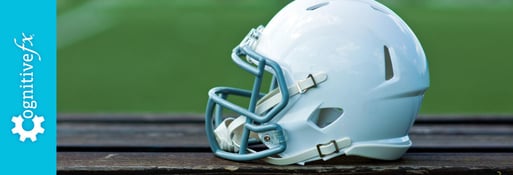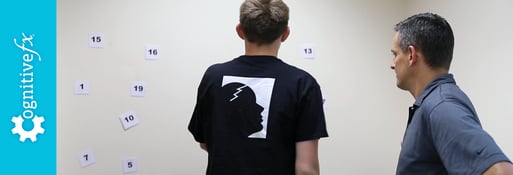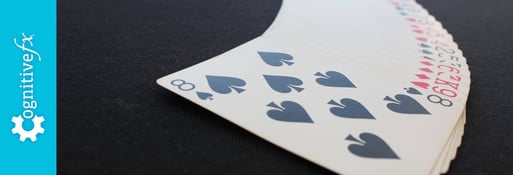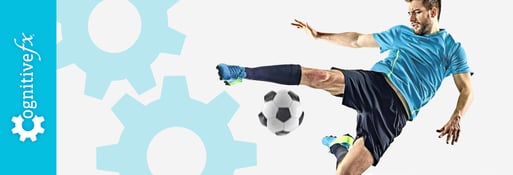Dealing with a concussion can be a confusing and frustrating experience. Unlike straight-forward illnesses that can be diagnosed by a simple lab test, there is no easy, one-size-fits-all test to diagnose concussions. Not everyone experiences the same symptoms, and the road to recovery is unpredictable.
If you’re an athlete who has experienced a concussion, things become even more complicated, especially if you have a sports-related concussion. You might be asking yourself additional questions, such as:
- When can I go back to my sport?
- What are the risks of returning to my sport?
- What can I do to stay in shape while I’m recovering?
- Will my performance suffer in the future because of my concussion?
At Cognitive FX, we treat hundreds of athletes and others who suffer from persistent concussion symptoms each year. In this post, we’ll answer common questions about sports concussion recovery and provide additional resources for those who need them.
However, there’s more to concussion recovery than physical healing. The psychological and emotional components of suffering and recovering from a concussion are very real, and athletes with sports concussions have their own particular set of challenges to deal with. So, in this article, we’ll also discuss common anxieties and questions that many athletes with sports concussions have about mental and emotional recovery.
Since that’s a lot of ground to cover, here’s an outline you can use to jump to the sections most relevant for you:
If you’re experiencing symptoms that won’t resolve after a sports concussion, you’re not alone. 95% of our patients experience statistically verified restoration of brain function. To see if you are eligible for treatment, schedule a consultation.
What Causes Sports Concussions?
A concussion is a mild traumatic brain injury (mild TBI). It can result from a direct hit to the head, such as when a player gets hit in the head by a ball, but you don’t actually have to hit your head to have a concussion. A concussion can result from any action that causes the head to whip back or to the side suddenly, such as when a player gets jostled suddenly and falls but doesn’t actually hit their head.
Some sports, such as football, are at high risk for concussions. However, the American Academy of Neurology reports that there are up to 3.8 million sports-related concussions in the United States each year, and they don’t all come from collision sports.
Which Sports Have the Highest Rate of Concussions?
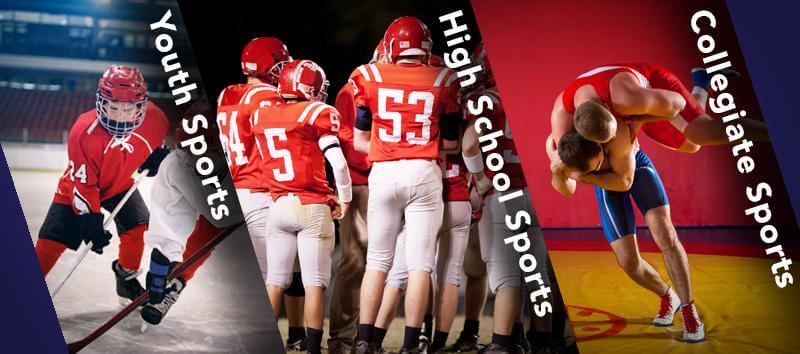
For youth sports (children between 5 and 18 years of age), the five activities with greatest concussion risk are bicycling, football, basketball, playground activities, and soccer, according to the Brain Injury Research Institute. One study showed that 47% of emergency room visits for sports-related concussions were by children between the ages of 12 and 15 years old.
When looking at high school sports, male football players and ice hockey players have the highest rates of concussion. For females, girls’ soccer has the highest rate. Another recent study revealed that, in general, more female high school soccer players experience a concussion than males. Basketball, baseball, cheerleading, and wrestling are also among the sports with the most concussions.
At the collegiate level, the sports with the most concussions for men are football, lacrosse, ice hockey, wrestling, and soccer. For women, the highest numbers are found in ice hockey, soccer, lacrosse, field hockey, and basketball.
In general, those who play contact sports experience more concussions than those playing non-contact sports, but it’s possible to sustain a concussion in any sport.
If you’re not sure if you’ve had a concussion, you might want to read “How Do You Know If You’ve Had a Concussion?” It will walk you through common questions, misunderstandings, and signs of a concussion.
Unfortunately, statistics show that once someone has experienced one concussion, they are 4 to 6 times more likely to experience another. In addition, the more concussions you experience, the greater your risk for suffering long-term effects like post-concussion syndrome, chronic traumatic encephalopathy (CTE), and more. Know the causes and symptoms of concussions and seek medical attention immediately if you might have a concussion.
Further reading: The long-term effects of multiple concussions
Concussion Prevention
With an increase in awareness of how common and dangerous sports concussions are in recent years, many sports have implemented protocols to help reduce and diagnose concussions.
Some sports have improved safety equipment, such as helmet quality and face shields, to try to reduce the number and severity of head injuries. Others have changed practice rules to reduce the quantity and intensity of physical contact. Some have implemented sideline concussion assessment protocols to get players to safety more quickly.
Some sports known to have a greater risk of concussions have also implemented baseline neuropsychological testing (click here for the Centers for Disease Control and Prevention [CDC] fact sheet).
With baseline testing, athletes may be given a series of balance and cognitive tests before the season begins. They might also be screened to determine if they are experiencing concussion symptoms or have any known previous concussions. If the athlete experiences a possible concussion during the season, they are given the tests again. Comparing the results can help diagnose a concussion.
Further reading: Concussion diagnosis and prevention in football
Sports Concussion Symptoms & Diagnosis
While better equipment, play guidelines, and baseline testing are all important advancements in protecting brain health, knowing and evaluating symptoms of a concussion is still vital. That’s because normal MRIs and CAT scans usually can’t diagnose a concussion; they can only detect structural damage to the brain. Most sports medicine doctors still rely primarily on reported symptoms to diagnose a concussion.
Further reading: Can an MRI diagnose concussion? Can a CT scan diagnose a concussion?
Read our guide to Symptoms of a Concussion for more details, but in general, common symptoms of a concussion include the following physical and cognitive impairments:
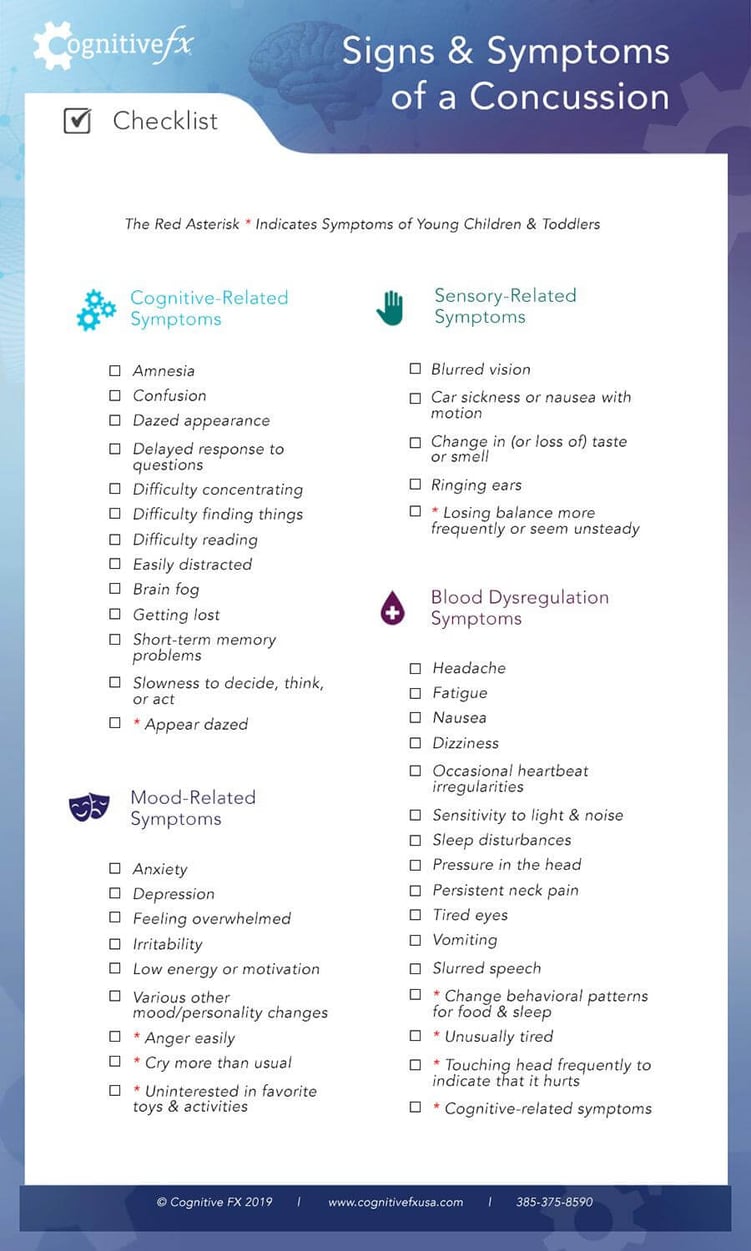
Even with all of the current awareness about concussions, concussion diagnosis and treatment is complex. Sometimes people even experience a concussion (or two or three) without realizing it. If you have a suspected concussion, seek medical care.
More and more athletic trainers are being taught how to recognize a concussion, but it can still slip under their radar. If you’re experiencing symptoms, look for a care provider who specializes in head injury diagnosis and treatment.
Remember that you can get a concussion without violent contact with another person or object. It can happen whether you’re playing a sport or not. You don’t have to experience loss of consciousness or memory loss for it to be real. If you had any kind of head trauma and are experiencing symptoms of a concussion that don’t go away after a few weeks, you should be evaluated for post-concussion syndrome.
Finally, if you’re experiencing any of these adult and pediatric signs of serious injury and brain trauma, visit your nearest emergency department as soon as possible:
- Bleeding
- Eyes aren’t tracking properly
- Pupils are dilated
- Convulsions or seizures
- Nausea and vomiting
- Being unresponsive or losing consciousness
- Being excessively sleepy
- Trouble walking or problems with balance
- Weakness on one side of the body
- Slurring their speech
- Blood or a clear fluid draining from the ears or nose.
Concussion Treatment and Recovery
If you’ve been diagnosed with a concussion, you probably want to know how long recovery is going to take and how soon you can get back to your sport. Unfortunately, the answer varies depending on your situation, overall health, specific injury, and many other factors.
How Long Will Recovery Take?
Research shows that most collegiate athletes return to baseline performance within 2 weeks. However, only 50% of high school athletes return to baseline within that time period. Many of them need up to 4 weeks to recover.
That said, every concussion is unique, as is the recovery process. If you’ve had a previous concussion, your symptoms and recovery might be completely different than before.
If you go more than six weeks without your symptoms resolving, there is a good chance that you have post-concussion syndrome. If you are experiencing symptoms of autonomic nervous system dysfunction (read more here), that could affect your recovery time as well.
What Should You Do Right After a Concussion Diagnosis?
Make sure you take the diagnosis seriously. Don’t brush off your symptoms and rush back into play. Some studies show that 90% of second concussions happen within 7 to 10 days of the first one. Your brain is injured, and you don’t want to risk another concussion. Although rare, a condition known as second-impact syndrome (SIS) could result in death if you sustain another concussion before healing from the first.
If you participated in baseline testing, you probably won’t be allowed to return to practice until you’ve returned to your baseline performance level. Some health care professionals still advise patients to avoid all physical, mental, and social activity until all symptoms have resolved. However, this advice to “cocoon” is outdated.
Studies now show that light exercise and activity should be resumed within a couple of days after a concussion, if possible, as long as that activity doesn’t induce significantly worse symptoms. It turns out that exercise (within limits) actually helps concussion recovery. As an athlete, this is good news if you’re worried about staying in shape. Read our guide to exercising after a concussion to learn how to exercise safely after a concussion.
During recovery, do your best to fit in 30 minutes of light exercise each day, some cognitive activity, and plenty of rest.
For a more in-depth recovery protocol, please see our post on how to treat a concussion.
What If Your Symptoms Aren't Going Away?
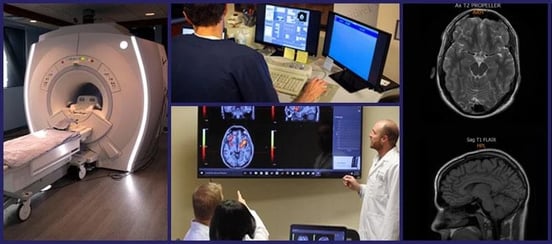
Persistent post-concussion symptoms can result from several complications that develop after a concussion.
Many of our patients struggle with poor neurovascular coupling (NVC), which is the dynamic relationship between blood vessels in the brain and the neurons that rely on them for the right nutrients at the right time. Concussions can disrupt neurovascular coupling, resulting in brain regions which struggle to perform their tasks. These struggles turn into common concussion symptoms like difficulty paying attention, brain fog, headaches, poor sleep, light and noise sensitivity, memory issues, and more.
Some other complications that can develop include vision problems, vestibular dysregulation (the vestibular system helps you balance and know where your head is relative to everything else around you), and autonomic nervous system dysfunction (your ANS governs many “automatic” body processes such as heart rate, blood pressure, digestion speed, urination, and more).
When concussion symptoms stubbornly persist, it usually takes a combination of physical and cognitive therapies for patients to recover. At Cognitive FX, we offer the most multidisciplinary, targeted treatment program in the world for post-concussion syndrome.
Some of the therapies we offer include…
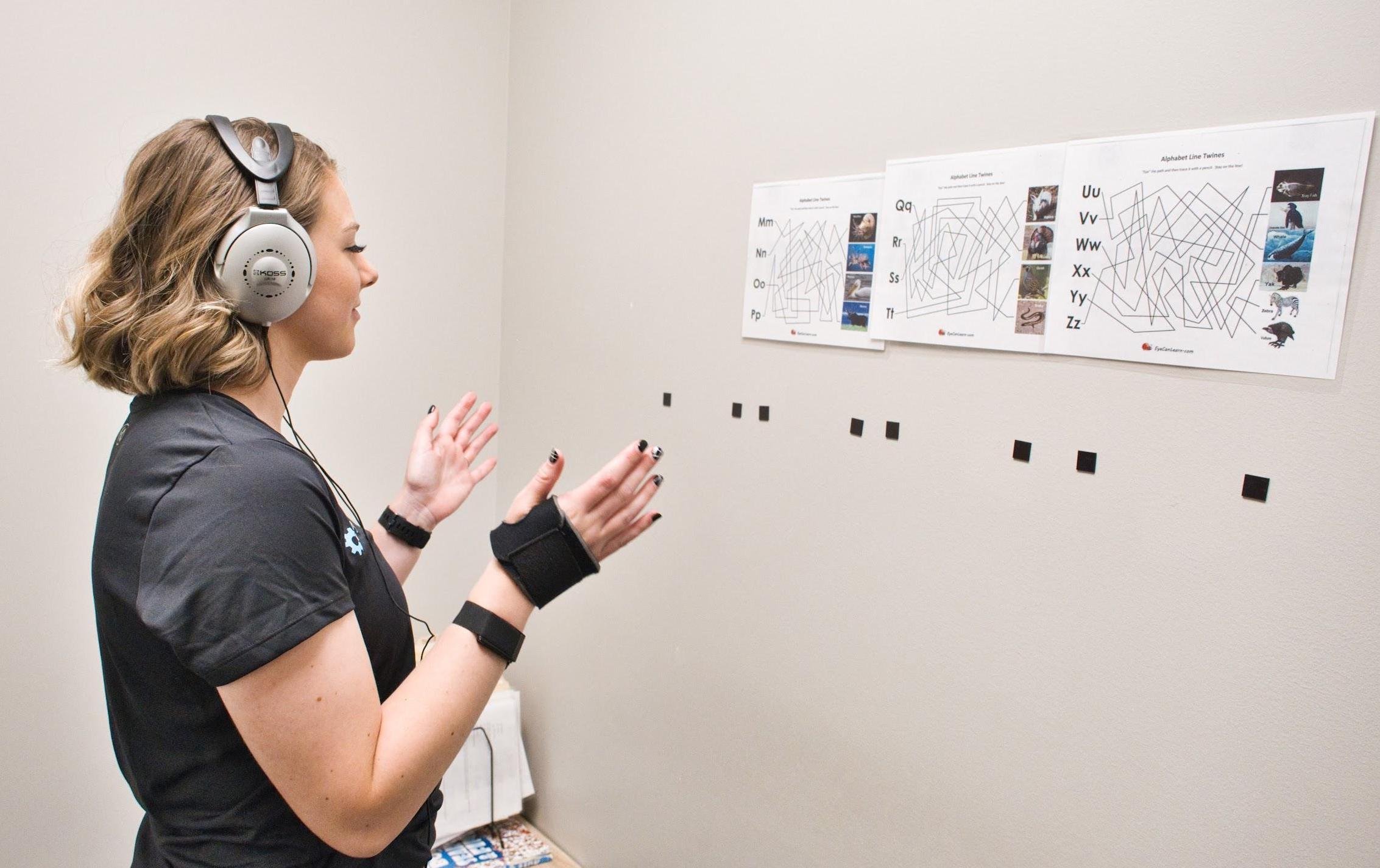 A therapist demonstrating sensorimotor therapy. She is clapping in time with a metronome while solving a visual maze to activate multiple brain regions at once.
A therapist demonstrating sensorimotor therapy. She is clapping in time with a metronome while solving a visual maze to activate multiple brain regions at once.
To learn what the treatment program is like, see these recovery stories shared by athletes:
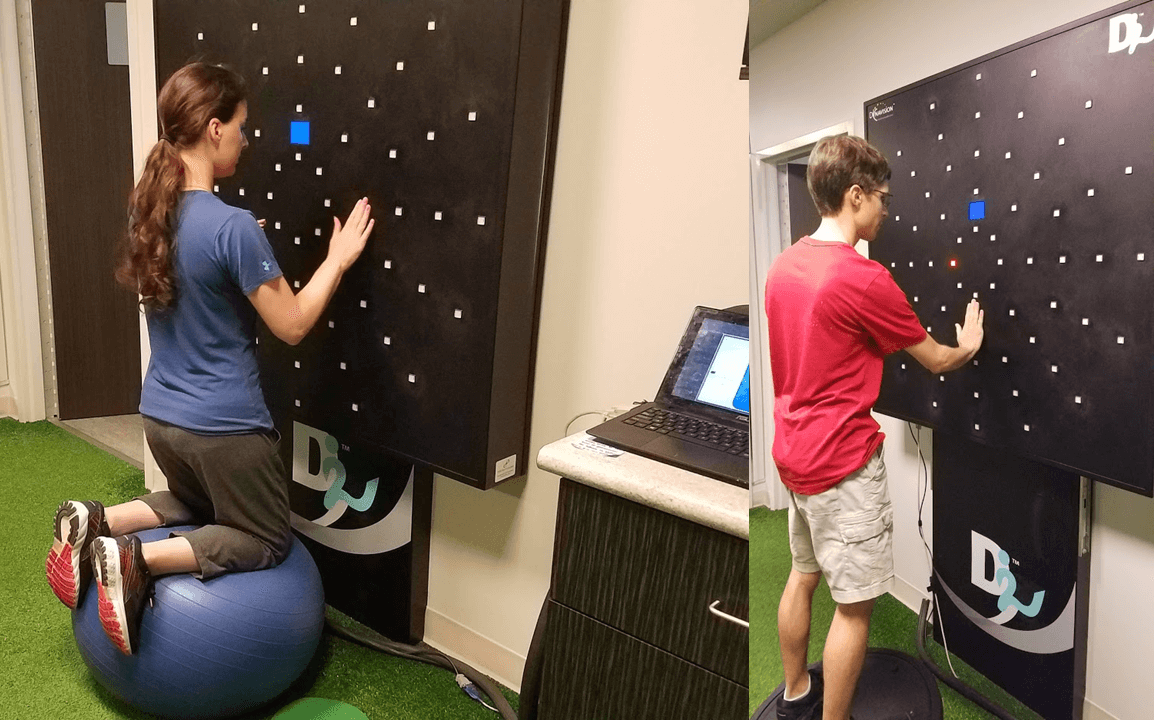 Patients demonstrate Dynavision therapy. In this case, their goal is to hit the green lights as fast as possible while avoiding the red lights.
Patients demonstrate Dynavision therapy. In this case, their goal is to hit the green lights as fast as possible while avoiding the red lights.
On average, our patients’ symptoms improve by 60% after just one week of treatment at our center specializing in neuroplasticity-based therapy. To see if you are eligible for treatment, schedule a consultation.
Mental and Emotional Recovery After a Sports-Related Concussion
Physically recovering from a concussion is important, and it’s what most people focus on. But suffering a concussion also involves mental and emotional distress, and dealing with that is just as important as dealing with the physical issues.
We spoke with Brittany Prijatel, a Sports Psychology Consultant, about common questions and struggles that athletes face during sports concussion recovery.

 Brittany received her masters degree in sports psychology from the University of Utah and worked with post-concussion syndrome patients at Cognitive FX before moving to AFSC/Magellan Federal as a Master Resilience Trainer/Performance Expert, where she works with soldiers on training mental skills.
Brittany received her masters degree in sports psychology from the University of Utah and worked with post-concussion syndrome patients at Cognitive FX before moving to AFSC/Magellan Federal as a Master Resilience Trainer/Performance Expert, where she works with soldiers on training mental skills.
Treatment and Recovery:
When Can I Return to My Sport?
It’s important to understand that recovery is a process — and it’s often unpredictable. So, how do you deal with that unknown psychologically? Key elements of success are:
- Crafting your mindset
- Setting realistic goals
- Having (and using) a good support system.
Let’s dive into each.
Crafting Your Mindset
“You are a whole person: How you think is going to impact how you feel and what you do,” said Brittany. “Understanding that connection is critical in recovery.”
Brittany coaches her clients to become aware of how they are feeling and what they are thinking. She uses a technique called reframing to help patients change the way they think about things.
For example, if you’re driving, and a car cuts you off in traffic, you’re going to have a thought about the event that triggers an emotion and a physical response. Consider two possible responses:
- You might think “That person could have damaged my car!” That would drive the emotion of anger. As a result, your heart rate might go up and you might even start driving more aggressively in response.
OR:
- You might think “Phew, I’m glad nothing bad happened.” That would trigger the emotion of gratitude and as a result, you might pay a little more attention to your driving.
These are two very different responses to the same event, which might lead to very different performance outcomes. The exact same process and practice can be applied to injury recovery as well. How we look at something that happens, and then become aware of and possibly change how we respond to that event, is reframing.
This process can be used during concussion recovery when you start feeling frustrated. Maybe you’re angry about your concussion, your symptoms, and the things you can no longer do. Maybe you’re angry that your recovery isn’t going as fast as you think it should be.
Awareness is a big step in the process. Brittany advised asking yourself, “What are you thinking? How’s your body responding? What emotions are you experiencing? And then ask yourself, ‘Is it helpful to you, or not?’”
Brittany added, “A lot of it is making sure that you’re focusing and putting your attention in the right places at the right time,” such as focusing on what you can do now to work toward recovery.
Setting Realistic Goals
It’s important to set realistic goals with the help of your treatment team. Patients have a tendency to set unrealistic goals on their own. For example, it’s probably unrealistic to set a goal of running a mile just one week after a concussion sidelines you if you’re having trouble walking two days into recovery.
Instead, it’s important to accept where you are and move forward from there. “A lot of people spend a lot of time comparing themselves to where they used to be or what they could do,” said Brittany. That constant comparison just creates frustration and isn’t helpful. On the other hand, setting realistic recovery goals allows you to stay in the present and focus on what you need to do.
That said, expect setbacks. Realize that experiencing one doesn’t mean the recovery process isn’t working. “When you’re going through rehabilitation from any kind of injury, there are going to be points where your body is going to plateau, or you’re going to hit a wall. Maybe it’s a physical wall, or maybe it’s a mental wall,” she said. “You need to take a step back and readjust that goal.”
Brittany also recommended practicing compassion toward yourself when these setbacks happen. We have a tendency to be overly critical of our own progress, because we have our own expectations of how our recovery should play out. Remember to use reframing during this process.
You can also “control the controllables,” Brittany said. “A lot of the time, we spend our time focusing on the things we can’t control, and when we do that, it’s going to take us way out of the realm of possibilities,” she said. “What’s in your control is what you’re doing in the present moment. It boils down to your thoughts, emotions, and behaviors.”
Finally, don’t forget to celebrate when you meet your goals — even seemingly small ones. “When you have those little wins, like, ‘I was able to remember my grocery list without writing it down,’ celebrate that!” Brittany encouraged. Those successes build your confidence.
Having and Using a Good Support System: Family and Friends
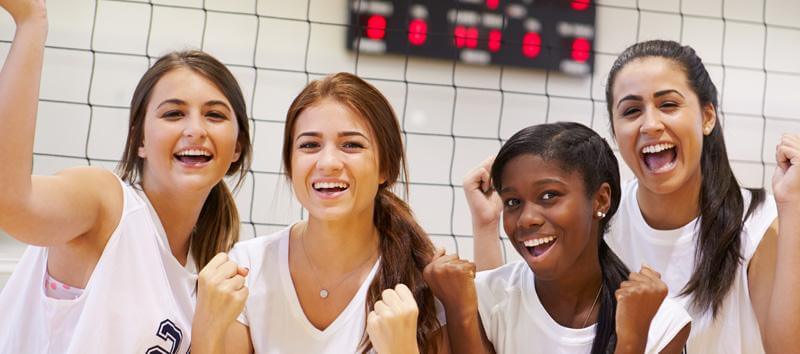
Another key component to successful recovery is having, and using, a good support system. Obviously, you want the support of a good medical team. But often, athletes disconnect from their social circle during recovery. “You’re not going to practice anymore. You’re not talking with coaches anymore. You’re not involved anymore,” Brittany said. “It’s very easy to naturally isolate yourself.”
In Brittany’s experience, people going through concussion recovery are sometimes reluctant to talk to people who have never experienced the difficulties and emotions of going through a concussion recovery. But she says it’s worth the effort.
“Try. Take 20 seconds of courage and be vulnerable with somebody else if they’re willing to be there at that moment and listen. Why not?” she said.
If you have homework to do as part of your rehabilitation process, you can also involve your family and friends in that. After EPIC treatment at Cognitive FX, we send patients home with specific exercises to continue their recovery at home. It’s helpful to have a friend or family member assist. For example, you might toss a tennis ball back and forth with a partner while walking and trying to solve mental math or word problems at the same time.
Finding Support Online
Going online for support groups is another option. Internet forums are a great way to connect with others who have gone through or are going through experiences similar to yours. Sometimes it’s easier to open up anonymously online, or to just scroll through comments to see what other people are saying. It’s also encouraging to hear someone say they finally did something you’ve been struggling to do, and it motivates you to keep working toward your goals.
Common Questions and Worries After a Sports Concussion
In this section, we’ll go through some common questions and anxieties that athletes have after a sports-related concussion. The big ones are:
- Who am I?
- Should I return to my sport?
- What problems could I have if I go back?
- What if I’m told I can’t go back to my sport?
Who Am I?
When a sport is a huge part of your life, and you suddenly can’t participate anymore — even temporarily — you may experience new emotions and confusion. “One of the biggest things that athletes experience after they’ve been injured or had a concussion is that loss of athletic identity,” said Brittany. “That is something they deal with on a daily basis.
Sometimes athletes tie their entire identity to a sport, and if it’s taken away from them by an injury, they might suddenly wonder who they are without it. It’s a time of grief and loss. They might be frustrated, anxious, sad, or angry — or all of those several times a day. Athletes spend so much time with teammates and training, and after a concussion, their lives and their daily schedule might completely change.
If you are going through this, you might also wonder if you’ll ever recover enough to return to your sport. You might worry you’ll be replaced. You might worry that you’ll never be as good as you were. These are all common anxieties.
This is the time to implement the strategies we discussed above: be aware of your thoughts and feelings; reframe; set realistic goals; and use your support system. Focus on what’s going to help you for now.
Should I Return to My Sport If I’m Cleared to?
Sometimes when people are forced to step back from something they’ve been very involved in, they start to reevaluate their commitment to it. You might be wondering if you should even return to play if you’re cleared. Maybe with time and space, you realize you’re just not as passionate as you once were about the sport. Maybe you want to sit this sports season out and then try again. Maybe you’re worried about the risk of further injury.
Assuming that you will be cleared to play again, Brittany’s advice is to first evaluate your motivation. Do you want to return? If you’ve realized that you just don’t enjoy it very much anymore, then the answer is easy.
However, if you are still motivated to go back to your sport, the next step is to look factually at your rehabilitation plan with your team. Objectively evaluate your progress, what you are able to do now, and what you will be able to do. Be aware of your emotions as you’re thinking through the decision. You have to decide if you are mentally ready to return as well as physically ready.
Am I Really OK? How Do I Deal With Anxiety?
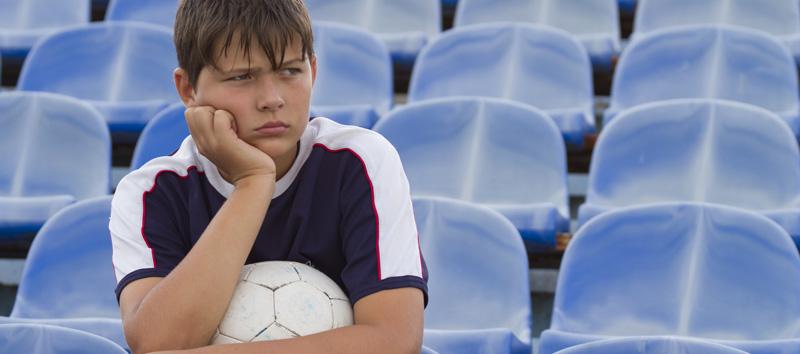
If you’ve been physically cleared to return to play, it’s still common to have anxieties about the risks. You might wonder if you’re really OK, or you might worry about reinjuring yourself and sustaining another concussion.
Brittany recommends several strategies for dealing with situations like this.
One way to deal with these anxieties is to go back to “control the controllables” and focus on the present. “A lot of times when we experience an anxiety or a fear, it’s because we’re thinking about something in the past, or we’re thinking about something in the future,” she said. “But that means that we’re not present focused.”
Her suggestion to overcome this is to focus on breathing. If you’re solely focused on your breathing, your mind isnt honed in on the things you can’t control. “That is something you can train. Mindfulness is focusing on the present moment,” she added.
Another strategy is to create a performance routine that helps you calm down and focus. You might create a step-by-step routine that you follow as you begin certain stages of your activities. Similar to how an athlete might get ready to step into the batter's box, kick a penalty kick, or shoot a free throw, a practiced performance routine builds comfort and confidence. The unique thing about a performance routine is that it is 100% adjustable to what works for you. It can include things like a couple deliberate breaths, a statement you repeat to yourself to get ready, imagery, etc.
“Imagery is creating or recreating an image in your mind,” Brittany said. It’s like intentional daydreaming. As an athlete, you’re going to create a script in your mind of what you want to happen. You practice it over and over and it will help build confidence.
“Imagery is a way that you can, without physically putting yourself in danger, practice some mental reps to help feel more comfortable, more confident, and to help manage some of the emotions you might be experiencing,” she said.
She explained that when you practice imagery, it almost tricks the brain and the body into thinking you’re actually doing the action you are imagining. It causes neurons to fire in your brain, admittedly to a lesser degree than if you were physically performing the task. However, the associated pathways in the brain are still being used, and it still builds confidence that you can do the task as imagined.
Brittany recommends that you also use as many of your senses in the imagery as possible. Imagine what the process feels like. Try to use your sense of smell, touch, and sight, sound, and even taste if you can. “The more senses you involve, the stronger that imagery will be,” she said.
Practice what you want to think, say, and do to overcome anxiety around those events, whether they’re of getting injured again or being able to perform at your old ability level.
For example, as a soccer player, if you get anxious just thinking about going up for a header, in your imagery you can imagine the butterflies in your stomach as you see the goalkeeper get ready to punt the ball. As that happens, you can incorporate how you want to respond when you feel butterflies in your stomach. Maybe you practice telling yourself that “this feeling is my body getting ready,” or “I feel these butterflies because I am excited!” It doesn’t guarantee injury prevention if you’re in a similar situation, but you’ll be better equipped to handle it.
What if My Coach or My Teammates Don’t Trust Me?
Another worry that some athletes have about returning to their sport after a concussion is that their coach or their teammates won’t trust them anymore, or will have a negative opinion of them.
In these situations, Brittany advises athletes to look factually at what is being said or done. Is there actual distrust? Are your teammates making negative comments? Are you being excluded in some way? Or could you merely be perceiving things in a negative way when that’s not the actual intention? Either way, one focal point is to turn your attention back to what you can control.
“Ultimately, you have little control on what they do,” Brittany said. “You have influence in the situation. You can go in and have a conversation with the coach or have a conversation with those teammates, but you don’t have any control over what they actually do.” One of the strategies she works with athletes on is to identify what is in their control and then help them create a plan that is effective and productive for themselves. Control what you can control.
What If I’m Told I Can’t Return to My Sport?
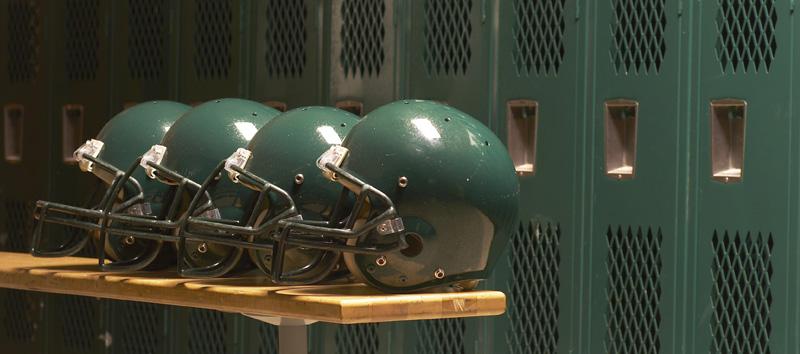
Sometimes, it’s just not safe or possible for an athlete to return to their sport after sustaining brain damage from a concussion, even though the desire and the motivation are still there. This news can be devastating.
First and foremost: If you become depressed, seek the help of a professional immediately. Quitting a beloved sport is a major life change, and it’s okay to seek help to find your way through this confusing and emotional time.
You will most likely need a lot of time, patience (with yourself and from others), and support to figure out what to do next. You may have already experienced something of a loss of identity after your injury first happened and you had to take a break from play, but if it’s now permanent, those feelings of loss and confusion can return.
“It’s OK to not be OK for a little bit,” Brittany stated. Continue to use your social support during this time of transition. Stay connected. Remember that you are more than just an athlete.
Think about your relationships and the other roles you have in life. What else are you involved in? Are there any other recreational activities you’d like to pursue that you never had time for before? Try to find another safe way to stay fit and active. If you thrive on competition, is there another activity that can provide that stimulation?
If you still absolutely love your sport and don’t want to leave it, can you find another way to stay involved? Can you be involved in coaching or managing a team? Perhaps you can mentor young athletes or get involved in promoting the sport in some way?
Moving Forward
Recovering from a concussion is not a simple, straight-line process. It’s physically, mentally, and emotionally challenging. As an athlete, you’ve probably surrounded yourself with a network of support: coaches, teammates, trainers, and others. Just as they can support you during your athletic training, they can provide support during your recovery from sports-related injuries, too.
That said, if your concussion symptoms haven’t gone away after a few weeks, you might be suffering from post-concussion syndrome. It’s important to find a good clinic that can evaluate you and treat your symptoms. We’ve written a guide to help you find the best concussion clinic to help you do that.
If you’re experiencing symptoms that won’t resolve after a sports concussion, you’re not alone. 95% of our patients experience statistically verified restoration of brain function. To see if you are eligible for treatment, schedule a consultation.

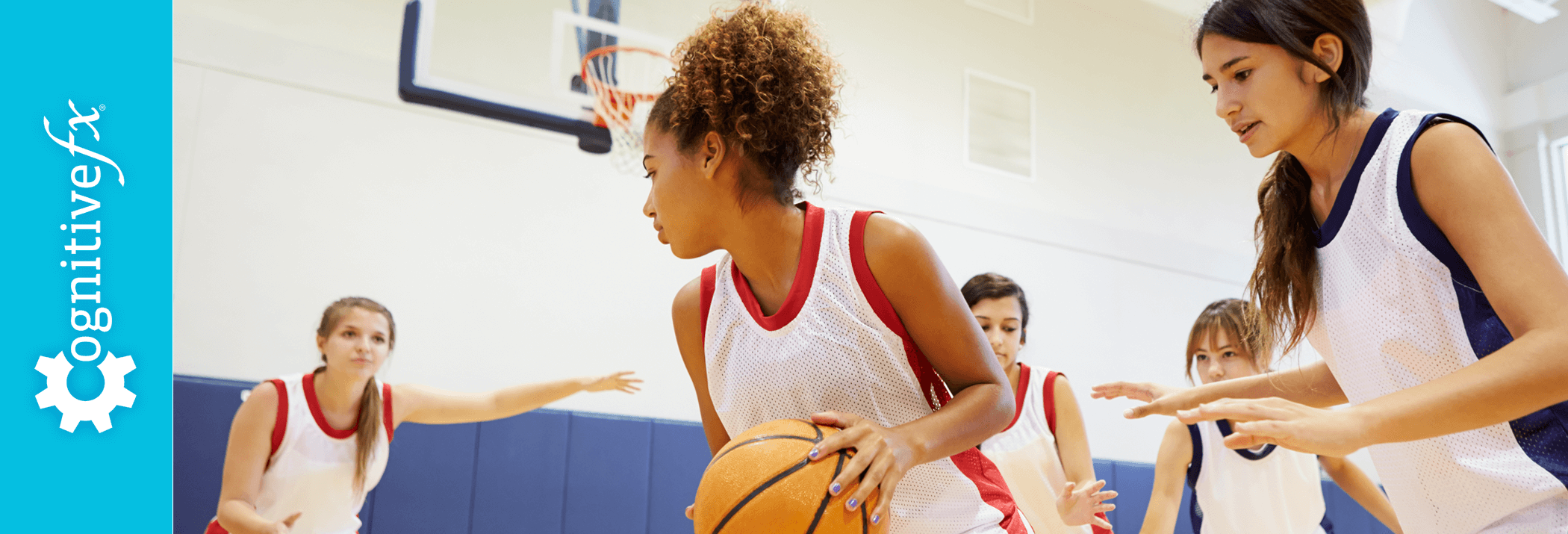






 Brittany received her masters degree in sports psychology from the University of Utah and worked with post-concussion syndrome patients at Cognitive FX before moving to AFSC/Magellan Federal as a Master Resilience Trainer/Performance Expert, where she works with soldiers on training mental skills.
Brittany received her masters degree in sports psychology from the University of Utah and worked with post-concussion syndrome patients at Cognitive FX before moving to AFSC/Magellan Federal as a Master Resilience Trainer/Performance Expert, where she works with soldiers on training mental skills. 



